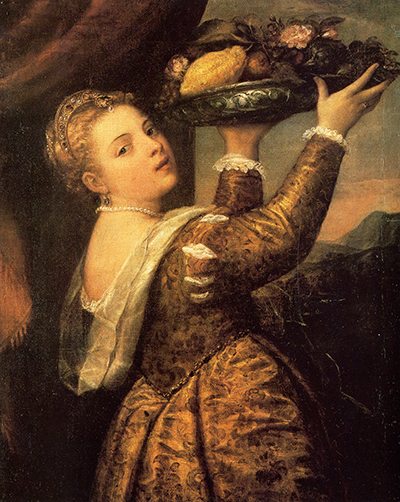Girl with a Basket of Fruits (Lavinia), created between the years 1555 and 1558 AD, is a painting by Titian that depicts a young woman holding aloft a platter which is heaped with fruit.
The girl, wearing a dress that is made from an expensive copper-coloured fabric that catches the light, has her back turned to the viewer and shows her face by looking over her shoulder. The shallow bowl that contains the fruit, fashioned from a metallic material such as pewter and decorated with a pattern of interlocking curves, is held up to the level of the girl’s forehead by both of her hands.
This oil-on-canvas painting, executed in the Mannerist style that was popular during the Late Renaissance, measures 102cm by 82cm and resides in Berlin’s Gemäldegalerie museum. The subject of the painting, believed by art historians to be Titian's daughter Lavinia Vecellio, is wearing a pearl necklace and an earring as well as a crescent-shaped tiara that is studded with gemstones. A wedding ring, worn under the knuckle of the girl's ring-finger, indicates that the subject of the painting is married while the quality of her attire and jewelry suggests that her husband is wealthy.
Light, emanating from a source to the left of the canvas, illuminates the left-hand side of the girl's face as well as her exposed back and neck. A thin line of shadow is visible along the right-hand side of the subject's face, neck and dress while a shadow that travels along the underside of her visible arm suggests that the light is falling from an elevated position. The girl's lips are slightly parted and her irises, positioned in the left-hand corners of her eyes, are gazing out towards the viewer while her nostrils and septum are made visible by the slight backwards tilt of her head.
Early Renaissance art, like the Medieval European art that had preceded it, was focused on religious themes while the emergence of Humanism in the sixteenth-century created the demand for artworks of a more anthropocentric nature that explored secular themes. The rise of financial capital, the establishment of lucrative trade routes with East Asia and the colonisation of the Americas led to the emergence of a powerful new socio-economic class in Europe. Bankers and merchants, enriched by new money, sought immortalisation in the painted form by the great artists of the day.
Both the landed aristocrats and city merchants wanted their portraits painted and artists, inspired by Humanist ideals as much as as by a love of money, were happy to take their commissions. Titian, who had painted Pope Paul III's portrait a decade earlier, chose to create Lavinia's portrait at the time when he was entering the later stage of his career. It is likely that Titian, who’s patrons had included the Doge of Venice and the Holy Roman Emperor, was living under the patronage of Philip II of Spain at the time in which the portrait was created.




